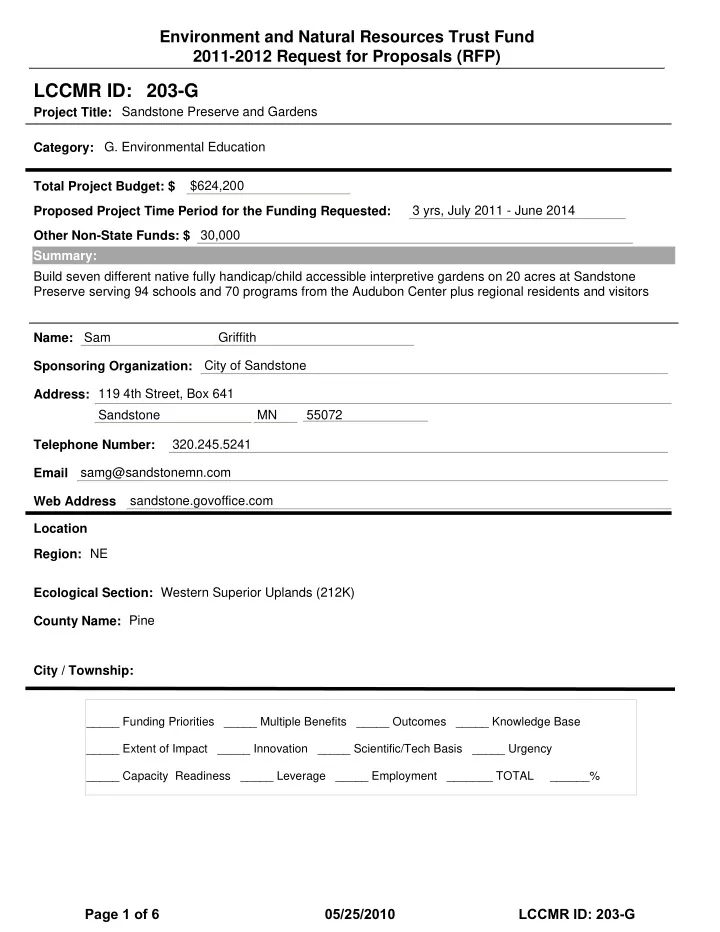

Environment and Natural Resources Trust Fund 2011-2012 Request for Proposals (RFP) LCCMR ID: 203-G Project Title: Sandstone Preserve and Gardens Category: G. Environmental Education Total Project Budget: $ $624,200 Proposed Project Time Period for the Funding Requested: 3 yrs, July 2011 - June 2014 Other Non-State Funds: $ 30,000 Summary: Build seven different native fully handicap/child accessible interpretive gardens on 20 acres at Sandstone Preserve serving 94 schools and 70 programs from the Audubon Center plus regional residents and visitors Sam Griffith Name: City of Sandstone Sponsoring Organization: 119 4th Street, Box 641 Address: Sandstone MN 55072 320.245.5241 Telephone Number: samg@sandstonemn.com Email sandstone.govoffice.com Web Address Location NE Region: Ecological Section: Western Superior Uplands (212K) Pine County Name: City / Township: _____ Funding Priorities _____ Multiple Benefits _____ Outcomes _____ Knowledge Base _____ Extent of Impact _____ Innovation _____ Scientific/Tech Basis _____ Urgency _____ Capacity Readiness _____ Leverage _____ Employment _______ TOTAL ______% Page 1 of 6 05/25/2010 LCCMR ID: 203-G
Sandstone Preserve and Gardens 2011-2012 MAIN PROPOSAL PROJECT TITLE: Sandstone Preserve and Native Gardens I. PROJECT STATEMENT - The City of Sandstone locate .5 miles off of I 35 in northern Pine County proposes constructing 7 native interpretive gardens: prairie, butterfly, wildflower, wildlife, woodland, native food and medicine, and bog. This will use approximately 20 acres of the 160 acre site formerly known as the Kettle River Environmental Education Center. Each garden will have at least one companion container garden and square yard garden as demonstrations of “take home” projects. Access to these educational gardens will be along two trails, a ½ and a ¼ mile looped asphalt handicap accessible trail system. No new buildings will be built with the exception of a handicap accessible pumped toilet facility, the only hardscape construction costs will be to make the site and the existing building handicap accessible. Why this project needs to be done – Both the Changing Demographics in Minnesota Implications for Natural Resources presentation prepared by the state Demographer in April 2006 and The 2007 Minnesota State Parks Research Report 2007 indicated that there were three populations that could be better served to foster enjoyment in the outdoors and maintain a healthy lifestyle. These populations are the elderly and obese, which are becoming an increasing percentage of the area resident and visiting regional populations, and small children. Conversations with both the Audubon Center of the North Woods and Banning State Park have confirmed that a project such as this would be useful for their current programs and building future programs. This project will create an educational resource not only for Audubon Center but also for local people in the region but also for visitors and others with special needs. Why this location: While elder, handicapped, and child scale outdoor exhibits are plentiful in the metro areas of the state they are not in the rural regions. They are also hard to add to existing facilities. The Audubon Center is seven miles from the Preserve and has existing education programs that serve approximately 8,000 students annually has no room to offer a more biologically diverse adult and small child friendly learning area. Banning State Park less than ¼ mile from the site also sees the need, but its mission is stated in statute and does not include this kind of development. Both facilities would incorporate this facility into their existing and programming and expand elderly opportunities. . Goals: These gardens will provide both a formal environmental education program through the Audubon Center and others and as an informal educational opportunity through interpretation. It will: • Provide access to a relatively compact facility with seven native plant habitats not found in either a single park or anywhere else in the region, the interpretation of which will encourage an appreciation and understanding of several native biomes. • Provide an accessible landscape for an underserved population: elderly, physically and mentally disabled or challenged persons as well as an appropriately scaled and controlled environment for small children • Encouraging visitor’s involvement by providing ideas for container and square yard native plantings that they can do in their own back yard. Population served: An abbreviated market assessment quantifies three general populations that will be served. Local population: There are about 53,000 permanent and seasonal households in the counties of Aitkin, Carlton, Kanabec and Pine. Nielsen – Claritas marketing data indicates household interest in gardening is between 69.17 % and 74.85 % in these Counties. Based on a market capture rate of 20% of the interested households, the estimate of visitors from the local counties at 2 people per visit is 15,500 annual visitors. Additionally there are special needs groups such as Pine Habilitation and Supported Employment Inc. (PHASE) headquartered in Sandstone serving 90 individuals. Visiting population: The visiting population serves is defined by two groups of guest: summer overnight guests at the Grand Casino Hinckley complex, and camping visitors at the three closet state parks. The cross interest participation rate for gaming and gardening is 65.05 percent and camping and gardening is 32.48. The capture rate is assumed to be 10% for both groups for a total of 23,870 visitors. It is felt that both of these capture rates are conservative given that there are no comparable facilities outside of the metro area. Audubon Center students: In 2008 -2008 the Center served approximately 8,000 additional adult courses could be expanded and modified with the availability of the gardens. 1 Page 2 of 6 05/25/2010 LCCMR ID: 203-G
Recommend
More recommend